4 Classroom Collaboration: Building A Monstrous Cake
Sarah Rene Nickel Moore
Ingredients
To create the Pressbook, students first complete a sequence of seven assignments. Students can then choose three of these assignments to revise for the Pressbook. You can read the ingredients (prompts) below:
Elevator Pitch
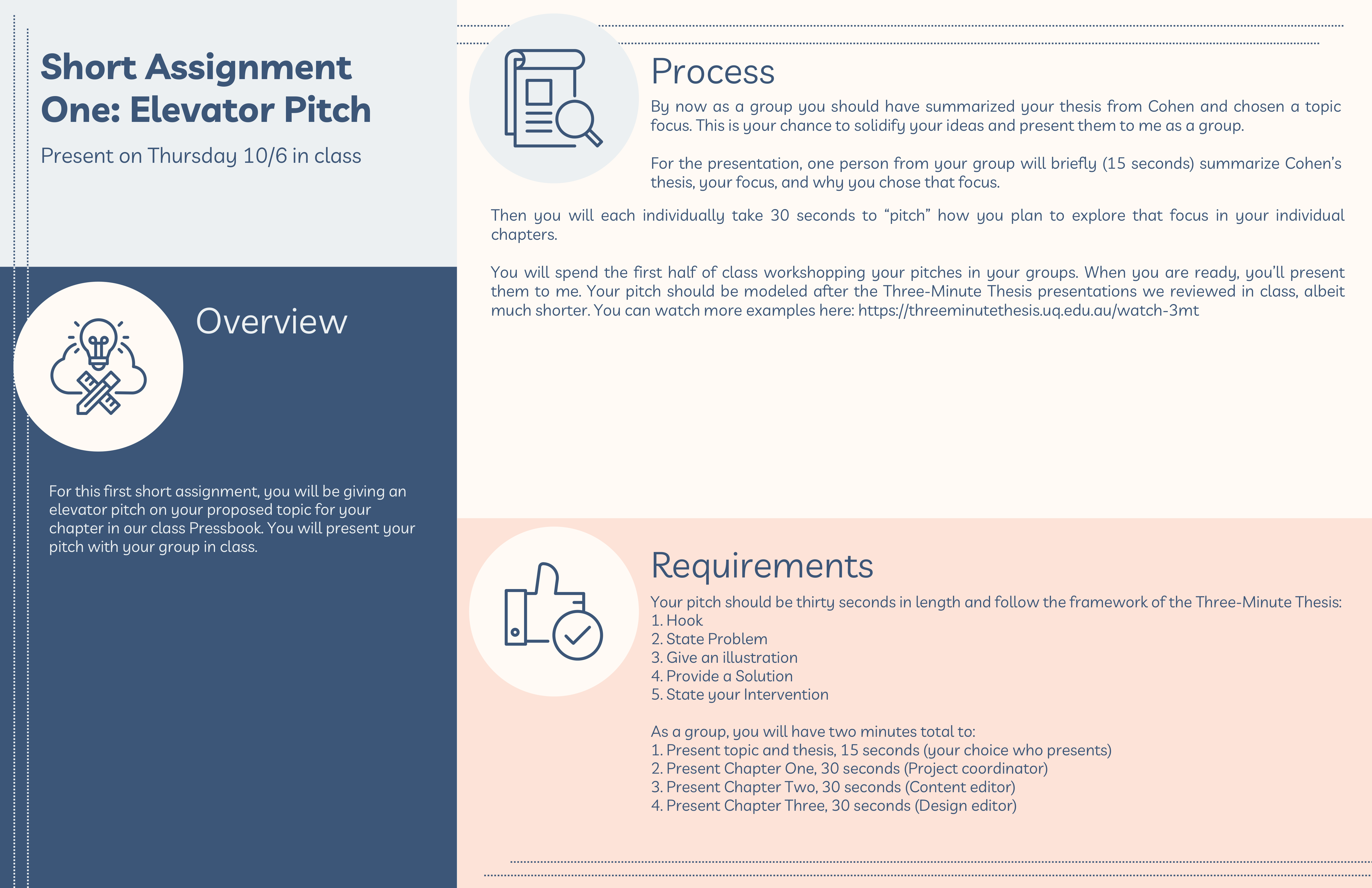
Elevator Pitch
Overview
For this first short assignment, you will be giving an elevator pitch on your proposed topic for your chapter in our class Pressbook. You will present your pitch with your group in class.
Process
By now as a group you should have summarized your thesis from Cohen and chosen a topic focus. This is your chance to solidify your ideas and present them to me as a group.
For the presentation, one person from your group will briefly (15 seconds) summarize Cohen’s thesis, your focus, and why you chose that focus. Then you will each individually take 30 seconds to “pitch” how you plan to explore that focus in your individual chapters.
You will spend the first half of class workshopping your pitches in your groups. When you are ready, you’ll present them to me. Your pitch should be modeled after the Three-Minute Thesis presentations we reviewed in class, albeit much shorter. You can watch more examples here: https://threeminutethesis.uq.edu.au/watch-3mt
Requirements
Your pitch should be thirty seconds in length and follow the framework of the Three-Minute Thesis:
- Hook
- State Problem
- Give an illustration
- Provide a Solution
- State your Intervention
As a group, you will have two minutes total to:
- Present topic and thesis, 15 seconds (your choice who presents)
- Present Chapter One, 30 seconds (Project coordinator)
- Present Chapter Two, 30 seconds (Content editor)
- Present Chapter Three, 30 seconds (Design editor)
Annotated Bibliography
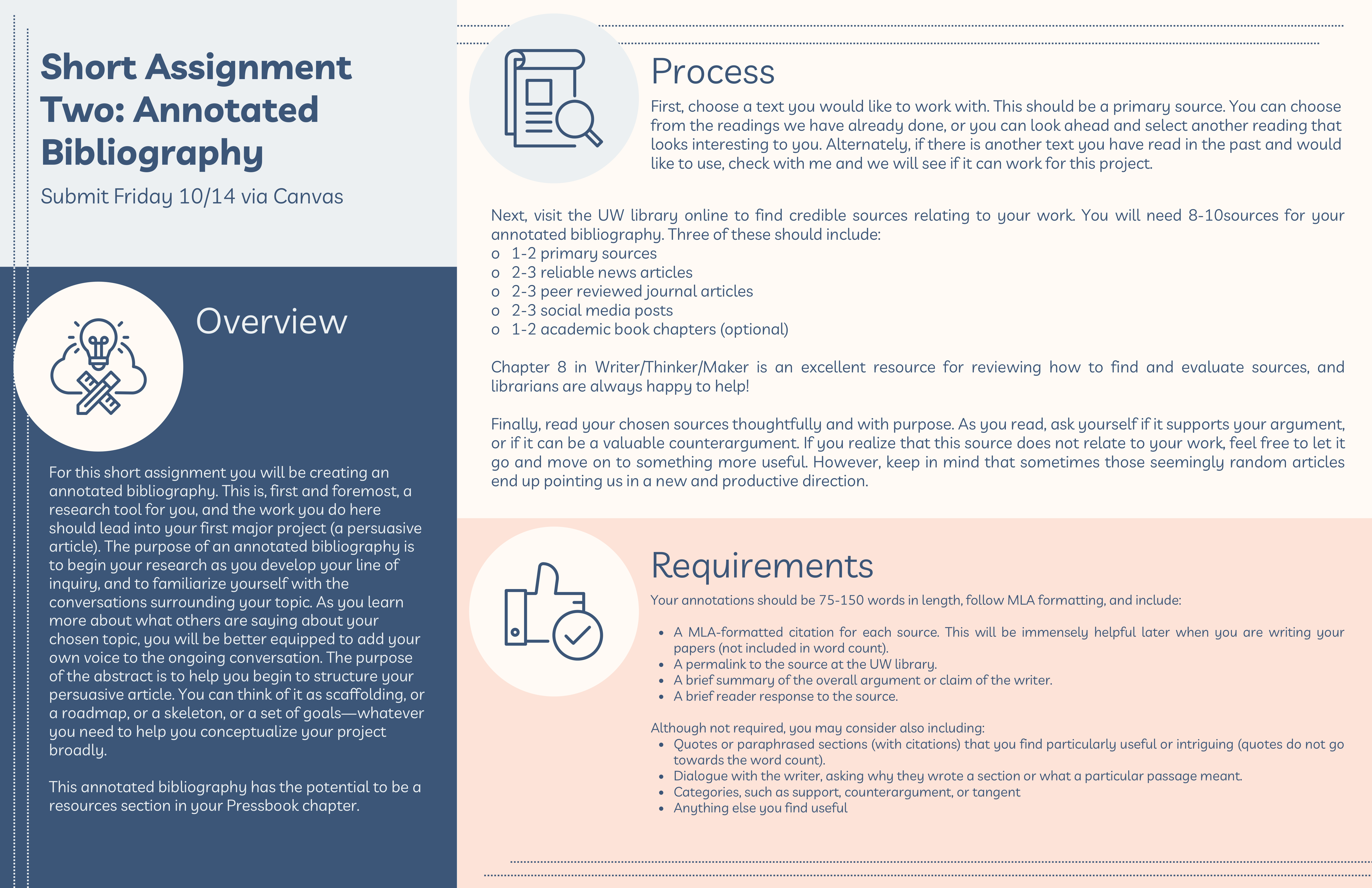
Annotated Bibliography
Overview
For this short assignment you will be creating an annotated bibliography. This is, first and foremost, a research tool for you, and the work you do here should lead into your first major project (a persuasive article). The purpose of an annotated bibliography is to begin your research as you develop your line of inquiry, and to familiarize yourself with the conversations surrounding your topic. As you learn more about what others are saying about your chosen topic, you will be better equipped to add your own voice to the ongoing conversation. The purpose of the abstract is to help you begin to structure your persuasive article. You can think of it as scaffolding, or a roadmap, or a skeleton, or a set of goals—whatever you need to help you conceptualize your project broadly.
This annotated bibliography has the potential to be a resources section in your Pressbook chapter.
Process
First, choose a text you would like to work with. This should be a primary source. You can choose from the readings we have already done, or you can look ahead and select another reading that looks interesting to you. Alternately, if there is another text you have read in the past and would like to use, check with me and we will see if it can work for this project.
Next, visit the UW library online to find credible sources relating to your work. You will need 8-10sources for your annotated bibliography. Three of these should include:
- 1-2 primary sources
- 2-3 reliable news articles
- 2-3 peer reviewed journal articles
- 2-3 social media posts
- 1-2 academic book chapters (optional)
Chapter 8 in Writer/Thinker/Maker is an excellent resource for reviewing how to find and evaluate sources, and librarians are always happy to help!
Finally, read your chosen sources thoughtfully and with purpose. As you read, ask yourself if it supports your argument, or if it can be a valuable counterargument. If you realize that this source does not relate to your work, feel free to let it go and move on to something more useful. However, keep in mind that sometimes those seemingly random articles end up pointing us in a new and productive direction.
Requirements
Your annotations should be 75-150 words in length, follow MLA formatting, and include:
- A MLA-formatted citation for each source. This will be immensely helpful later when you are writing your papers (not included in word count).
- A permalink to the source at the UW library.
- A brief summary of the overall argument or claim of the writer.
- A brief reader response to the source.
Although not required, you may consider also including:
- Quotes or paraphrased sections (with citations) that you find particularly useful or intriguing (quotes do not go towards the word count).
- Dialogue with the writer, asking why they wrote a section or what a particular passage meant.
- Categories, such as support, counterargument, or tangent
- Anything else you find useful
Although I will be evaluating these annotations, they are most importantly for you. Everybody structures their annotated bibliographies differently. You may write yours in paragraph form, bulleted form, or another form that is useful to you. I just ask that it be readable and comprehensible to me—if I can’t read it, I can’t give you constructive feedback!
Infographic
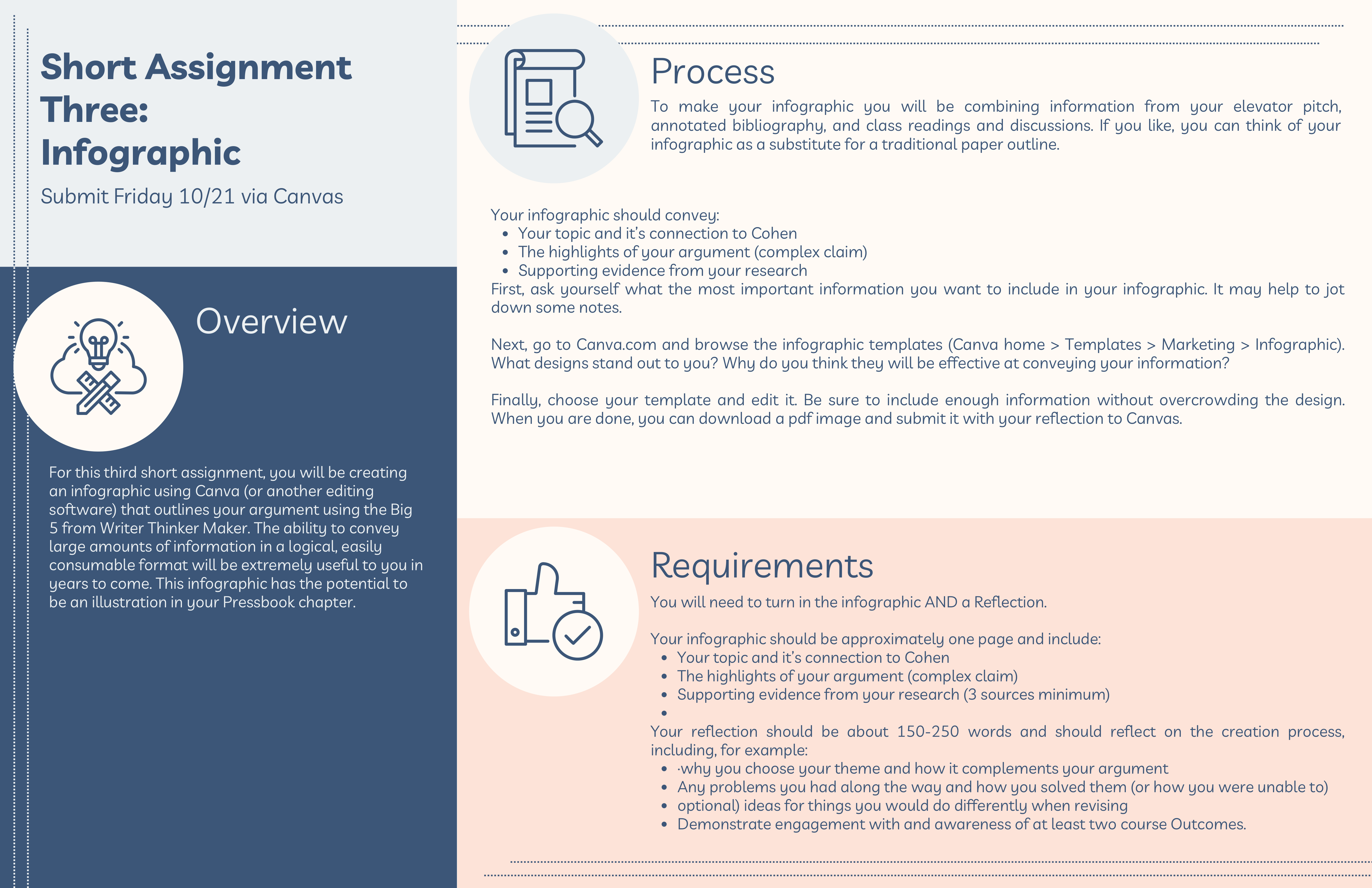
Infographic
Overview
For this third short assignment, you will be creating an infographic using Canva (or another editing software) that outlines your argument using the Big 5 from Writer Thinker Maker. The ability to convey large amounts of information in a logical, easily consumable format will be extremely useful to you in years to come. This infographic has the potential to be an illustration in your Pressbook chapter.
Process
To make your infographic you will be combining information from your elevator pitch, annotated bibliography, and class readings and discussions. If you like, you can think of your infographic as a substitute for a traditional paper outline.
Your infographic should convey:
- Your topic and it’s connection to Cohen
- The highlights of your argument (complex claim)
- Supporting evidence from your research
First, ask yourself what the most important information you want to include in your infographic. It may help to jot down some notes.
Next, go to Canva.com and browse the infographic templates (Canva home > Templates > Marketing > Infographic). What designs stand out to you? Why do you think they will be effective at conveying your information?
Finally, choose your template and edit it. Be sure to include enough information without overcrowding the design. When you are done, you can download a pdf image and submit it with your reflection to Canvas.
Requirements
You will need to turn in the infographic AND a Reflection.
Your infographic should be approximately one page and include:
- Your topic and it’s connection to Cohen
- The highlights of your argument (complex claim)
- Supporting evidence from your research (3 sources minimum)
Your reflection should be about 150-250 words and should reflect on the creation process, including, for example:
- why you choose your theme and how it complements your argument
- Any problems you had along the way and how you solved them (or how you were unable to)
- (optional) ideas for things you would do differently when revising
- Demonstrate engagement with and awareness of at least two course Outcomes.
Public-Facing Article
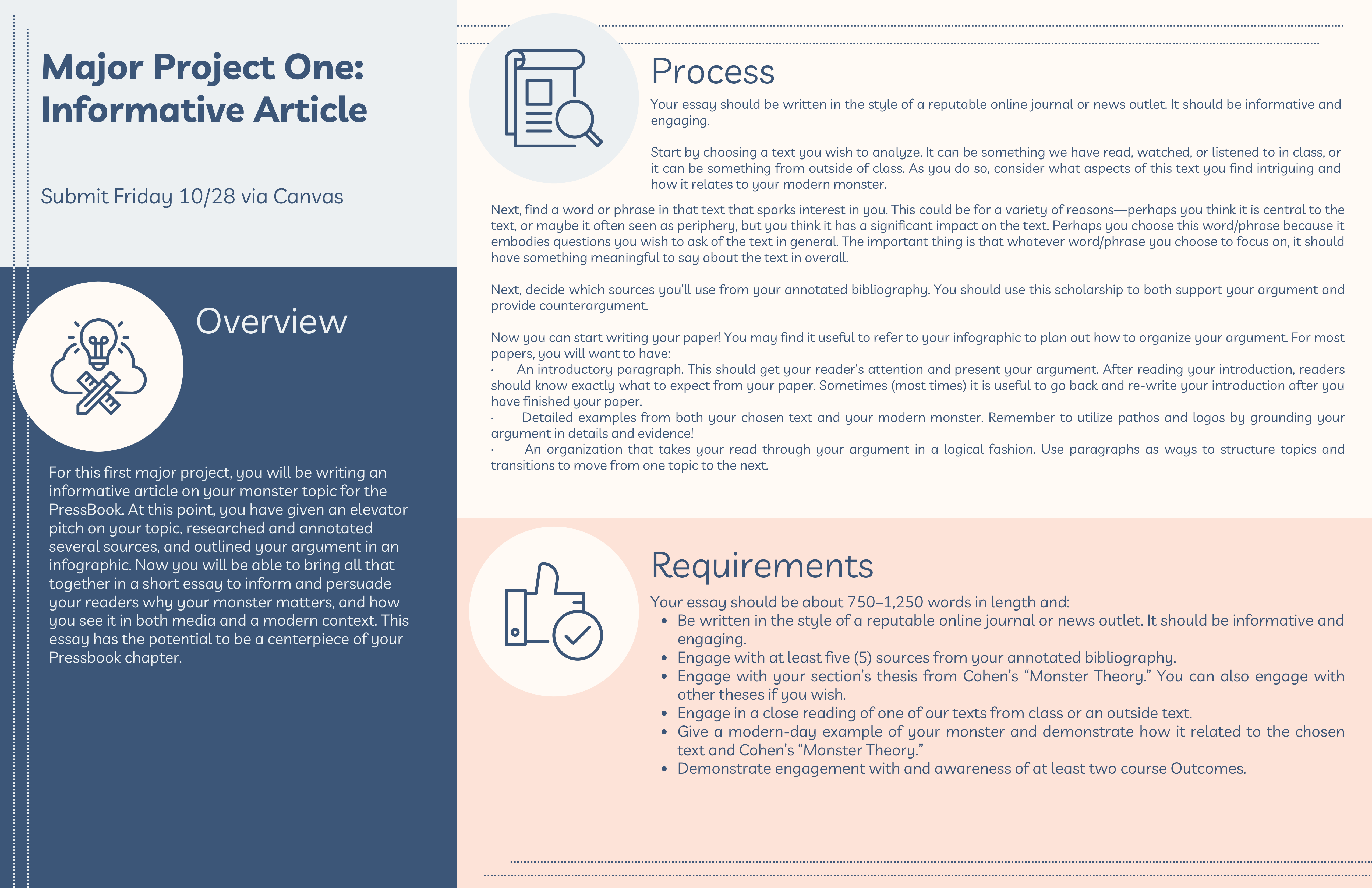
Public-facing Article
Overview
For this first major project, you will be writing an informative article on your monster topic for the PressBook. At this point, you have given an elevator pitch on your topic, researched and annotated several sources, and outlined your argument in an infographic. Now you will be able to bring all that together in a short essay to inform and persuade your readers why your monster matters, and how you see it in both media and a modern context. This essay has the potential to be a centerpiece of your Pressbook chapter.
Attention to detail is critical in this assignment—every argument you make should be supported with specific evidence from the text and thoughtful analysis. In this essay you will be practicing close reading, which is a specific method of engaging with texts that developed out of New Critical theory in the 1950s. While much of New Criticism is no longer practiced, close reading persists as a useful way to methodically study a text in a way that focuses on details to find meaning both inside and outside the text. In addition, WTM defines close reading as “an interpretive technique that often focuses on one particular part of a text—usually a short passage that can be as long as a couple paragraphs or as short as the title. A close reading will place particular emphasis on individual words, phrases, and sentences” (378). For this assignment, that means that we will be focusing on the details in the text you have chosen to analyze to better understanding of your modern monster.
Process
Your essay should be written in the style of a reputable online journal or news outlet. It should be informative and engaging.
Start by choosing a text you wish to analyze. It can be something we have read, watched, or listened to in class, or it can be something from outside of class. As you do so, consider what aspects of this text you find intriguing and how it relates to your modern monster.
Next, find a word or phrase in that text that sparks interest in you. This could be for a variety of reasons—perhaps you think it is central to the text, or maybe it often seen as periphery, but you think it has a significant impact on the text. Perhaps you choose this word/phrase because it embodies questions you wish to ask of the text in general. The important thing is that whatever word/phrase you choose to focus on, it should have something meaningful to say about the text in overall.
Next, decide which sources you’ll use from your annotated bibliography. You should use this scholarship to both support your argument and provide counterargument.
Now you can start writing your paper! You may find it useful to refer to your infographic to plan out how to organize your argument. For most papers, you will want to have:
- An introductory paragraph. This should get your reader’s attention and present your argument. After reading your introduction, readers should know exactly what to expect from your paper. Sometimes (most times) it is useful to go back and re-write your introduction after you have finished your paper.
- Detailed examples from both your chosen text and your modern monster. Remember to utilize pathos and logos by grounding your argument in details and evidence!
- An organization that takes your read through your argument in a logical fashion. Use paragraphs as ways to structure topics and transitions to move from one topic to the next.
Requirements
Your essay should be about 750–1,250 words in length and:
- Be written in the style of a reputable online journal or news outlet. It should be informative and engaging.
- Engage with at least five (5) sources from your annotated bibliography.
- Engage with your section’s thesis from Cohen’s “Monster Theory.” You can also engage with other theses if you wish.
- Engage in a close reading of one of our texts from class or an outside text.
- Give a modern-day example of your monster and demonstrate how it related to the chosen text and Cohen’s “Monster Theory.”
- Demonstrate engagement with and awareness of at least two course Outcomes.
For this first assignment, I ask that you start with the good practice of putting everything in MLA formatting. We will cover this more in depth later, but for now know that the Purdue OWL website is an excellent resource (www.prudue.owl.com). In short, use 12-point font, Times New Roman font, double spaced, 1-inch margins. Include your name, the class, instructor, and date in the upper left corner of the page, and number every page in the upper right hand corner. You should also have a title relevant to your topic.
Short Form Media
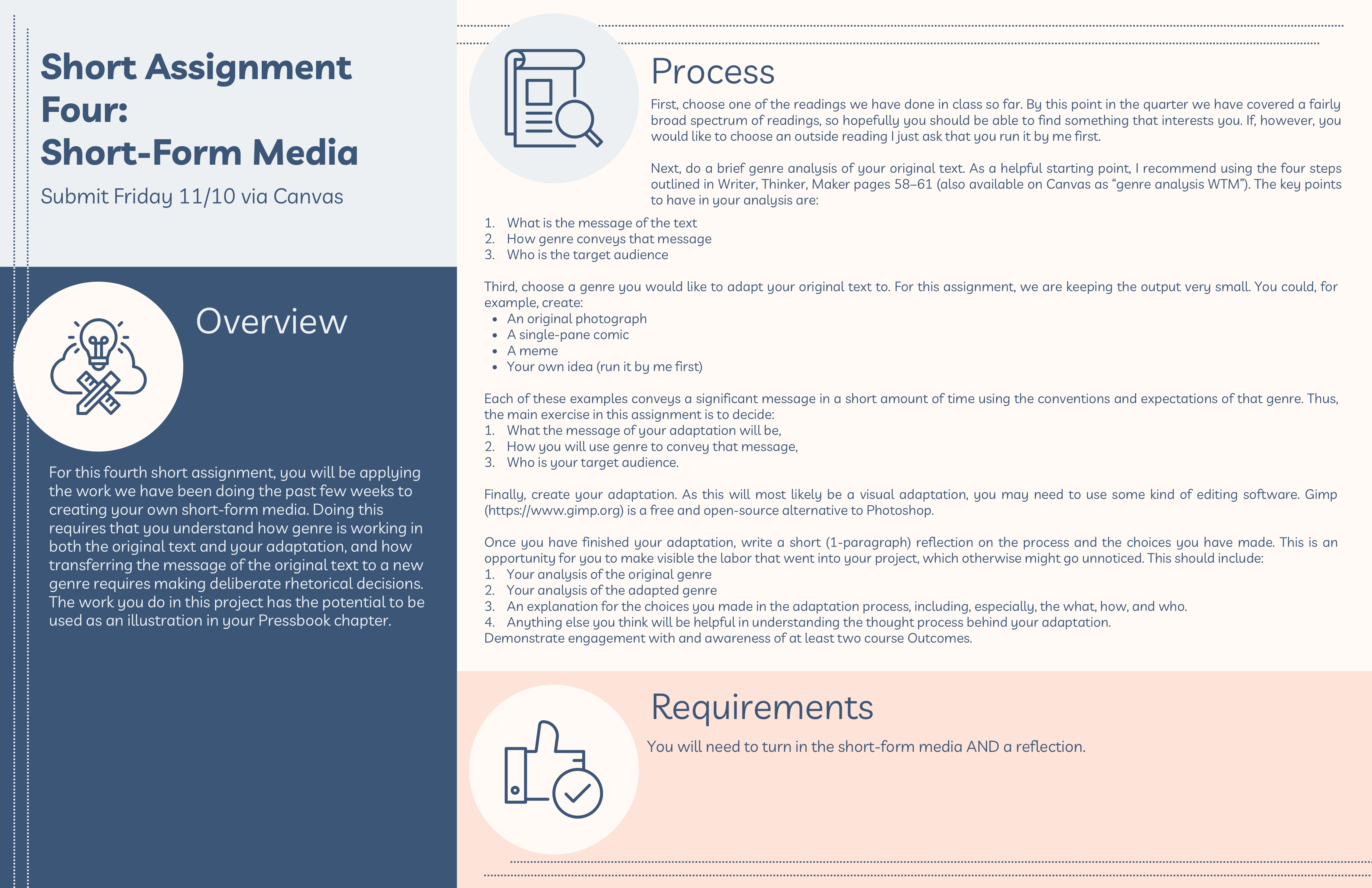
Short Form Media
Overview
For this fourth short assignment, you will be applying the work we have been doing the past few weeks to creating your own short-form media. Doing this requires that you understand how genre is working in both the original text and your adaptation, and how transferring the message of the original text to a new genre requires making deliberate rhetorical decisions. The work you do in this project has the potential to be used as an illustration in your Pressbook chapter.
Process
First, choose one of the readings we have done in class so far. By this point in the quarter we have covered a fairly broad spectrum of readings, so hopefully you should be able to find something that interests you. If, however, you would like to choose an outside reading I just ask that you run it by me first.
Next, do a brief genre analysis of your original text. As a helpful starting point, I recommend using the four steps outlined in Writer, Thinker, Maker pages 58–61 (also available on Canvas as “genre analysis WTM”). The key points to have in your analysis are:
- What is the message of the text
- How genre conveys that message
- Who is the target audience
Third, choose a genre you would like to adapt your original text to. For this assignment, we are keeping the output very small. You could, for example, create:
- An original photograph
- A single-pane comic
- A meme
- Your own idea (run it by me first)
Each of these examples conveys a significant message in a short amount of time using the conventions and expectations of that genre. Thus, the main exercise in this assignment is to decide:
- What the message of your adaptation will be,
- How you will use genre to convey that message,
- Who is your target audience.
Finally, create your adaptation. As this will most likely be a visual adaptation, you may need to use some kind of editing software. Gimp (https://www.gimp.org) is a free and open-source alternative to Photoshop.
Once you have finished your adaptation, write a short (1-paragraph) reflection on the process and the choices you have made. This is an opportunity for you to make visible the labor that went into your project, which otherwise might go unnoticed. This should include:
- Your analysis of the original genre
- Your analysis of the adapted genre
- An explanation for the choices you made in the adaptation process, including, especially, the what, how, and who.
- Anything else you think will be helpful in understanding the thought process behind your adaptation.
- Demonstrate engagement with and awareness of at least two course Outcomes.
Requirements
You will need to turn in the short-form media AND a reflection.
Monstrous Exhibit
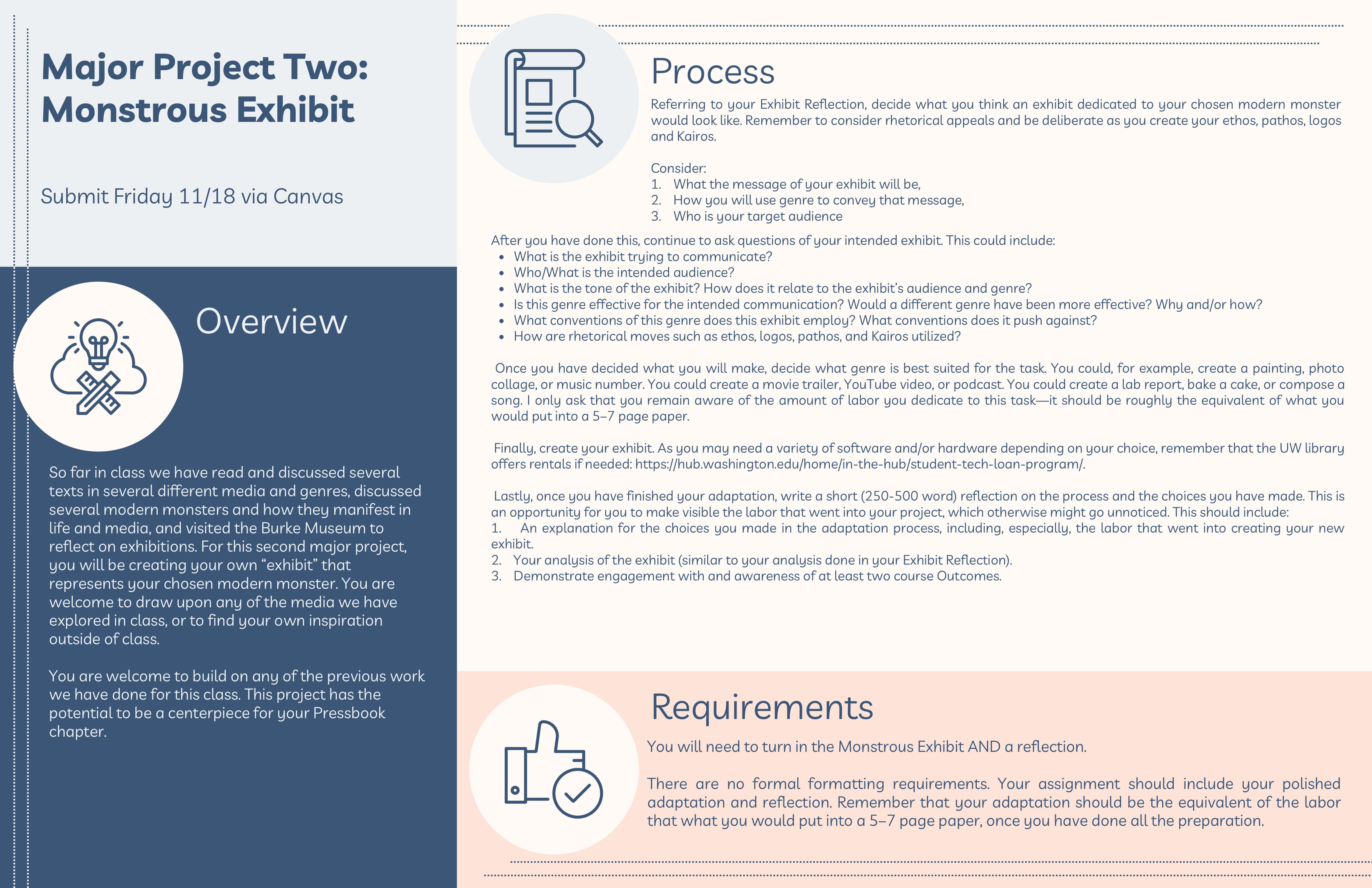
Monstrous Exhibit
Overview
So far in class we have read and discussed several texts in several different media and genres, discussed several modern monsters and how they manifest in life and media, and visited the Burke Museum to reflect on exhibitions. For this second major project, you will be creating your own “exhibit” that represents your chosen modern monster. You are welcome to draw upon any of the media we have explored in class, or to find your own inspiration outside of class.
You are welcome to build on any of the previous work we have done for this class. This project has the potential to be a centerpiece for your Pressbook chapter.
Process
Referring to your Exhibit Reflection, decide what you think an exhibit dedicated to your chosen modern monster would look like. Remember to consider rhetorical appeals and be deliberate as you create your ethos, pathos, logos and Kairos.
Consider:
- What the message of your exhibit will be,
- How you will use genre to convey that message,
- Who is your target audience
After you have done this, continue to ask questions of your intended exhibit. This could include:
- What is the exhibit trying to communicate?
- Who/What is the intended audience?
- What is the tone of the exhibit? How does it relate to the exhibit’s audience and genre?
- Is this genre effective for the intended communication? Would a different genre have been more effective? Why and/or how?
- What conventions of this genre does this exhibit employ? What conventions does it push against?
- How are rhetorical moves such as ethos, logos, pathos, and Kairos utilized?
Once you have decided what you will make, decide what genre is best suited for the task. You could, for example, create a painting, photo collage, or music number. You could create a movie trailer, YouTube video, or podcast. You could create a lab report, bake a cake, or compose a song. I only ask that you remain aware of the amount of labor you dedicate to this task—it should be roughly the equivalent of what you would put into a 5–7 page paper.
Finally, create your exhibit. As you may need a variety of software and/or hardware depending on your choice, remember that the UW library offers rentals if needed: https://hub.washington.edu/home/in-the-hub/student-tech-loan-program/.
Lastly, once you have finished your adaptation, write a short (250-500 word) reflection on the process and the choices you have made. This is an opportunity for you to make visible the labor that went into your project, which otherwise might go unnoticed. This should include:
- An explanation for the choices you made in the adaptation process, including, especially, the labor that went into creating your new exhibit.
- Your analysis of the exhibit (similar to your analysis done in your Exhibit Reflection).
- Demonstrate engagement with and awareness of at least two course Outcomes.
Requirements
You will need to turn in the Exhibit AND a Reflection.
There are no formal formatting requirements. Your assignment should include your polished adaptationand reflection. Remember that your adaptation should be the equivalent of the labor that what you would put into a 5–7 page paper, once you have done all the preparation.
Recipe Steps
Creating the PressBook
Students work collaboratively over the course of the quarter to create the Pressbook from the assignments completed above. Students were each assigned specific roles that allowed them to develop transferable skills in project management.
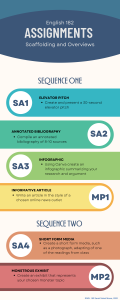
Overview
In this class we will be using Pressbooks a publishing platform hosted by the UW Libraries, to create and publish a book together!
There will be six sections. Each section will include content that you will create and revise as you complete your various assignments throughout the quarter. Publishing a book requires a lot of coordination and scheduling, but we can do this!
Process
To create this book, we will work individually, in small groups, and together as a class. The class will be divided into six groups of three.
Individual work
You will each work individually to create content for the book. This content may take the form of short essays, info-graphs, illustrations, videos, and more. All this content will be created as part of the required assignments for this class.
Small group work
Working in groups of three, you will coordinate the production of your chapter. Each person in the group has a role with specific tasks:
Project Coordinator:
- The project coordinator will work with group members to develop a schedule and timeline in conjunction with class deadlines,
- Communicate any problems with the instructor,
- And support group members as needed.
Content Editor:
- The content editor will run the in-class peer review sessions,
- Give meaningful feedback on content to each group member,
- And discuss ideas for revision and develop a revision plan.
Design Editor:
- The design editor will ensure that all contributions complement and work well together,
- Ensure styling across all contributions,
- Ensure that all text and graphics display correctly and that embedded links work.
Application
As you can see, the work you put into publishing this book translates easily to real-world applications for employment, grad school, and other venues. After this class, for example, you will be able to ask me for a letter of recommendation in which I can point to specific tasks and deliverables you completed, and link to the final product—a complete book—to attest to your ability to plan, develop, and execute a long-term task.
Completing this book also aligns with course outcomes and requirements for composition credit in the Program in Writing and Rhetoric.
Prompt given to students:
Overview
Your final assignment for this class is an online PressBook, which is worth 70% of your final grade. The PressBook is your chance to show both yourself and me that your writing has developed over the course of the quarter. As such, the focus of the PressBook is revision of your original assignment and reflection on the writing process. Your online PressBook will include the following components:
- Introductory Reflection
- Showcase: a section of your revised assignments
- Includes 2 short assignments (SA) and 1 major project (MP).
- A brief Reflection for each assignment.
- Final Reflection
- Compendium: a section with all the drafts you chose not to revise
- No Reflection essays in the Compendium.
- Note: All these drafts must be included AND the appropriate page length in order for your PressBook to be considered complete!
- You will submit all Showcase materials to the PressBook (unless otherwise determined by us). You will submit your Reflection materials to the PressBook prompt on Canvas, which is also where you will see your grade and feedback.
Process and Components
The PressBook consists of a combination of revised writing and reflection on that writing. You can think of the reflections as combining to form one large narrative: there is an introduction, three major sections, and a conclusion. The reflections are also a practice in meta-cognition, that is, thinking about the writing process. This is useful in that it makes you, the writer, aware of the choices you are making as you write. It also allows you to make those choices visible to me, your reader. With that in mind, think about your reflections as opportunities to make visible your deliberate writing choices and revisions.
The Showcase
All Showcase projects are submitted to PressBook
This section includes three revised assignments, uploaded to your PressBook chapter. You should have one Major Project, and two Small Assignments. Which assignments you choose is up to you—you could choose based on a project you enjoyed and would like to revisit, or a project that you feel could really use some improvement, or a project that you think you would benefit from spending more time with.
Each assignment should go through significant revision. Remember, revision is different from proofreading! Your revised projects should reflect careful thought and consideration as to how you can better convey your message or claim. As you begin revising, consider:
- How can you revise these assignments to form a cohesive chapter? This is the biggest entry point to revision for the PressBook.
- What have you learned over the course that you could now apply to improve your writing? Think especially about the Big 5 (WTM 275-283): central claim, counterargument or concession, evidence, stakes, and road map. Consider also audience, genre, and rhetorical appeals (ethos, pathos, logos, and Kairos). You do not have to apply all of these, but this may be a good way to begin thinking about the process.
- Return to the feedback you have received both from me (your instructor) and your peers. This is an excellent place to get ideas for how you can improve your project.
- Each of your three showcase pieces must show evidence of substantial revision Aim to increase each rubric area at least one grade e.g. a “good” to a “strong” or a “strong” to an “outstanding.”
Reflections
All Reflections are submitted to Canvas
Introductory Reflection (300–500 words)
Your Introductory Reflection (also your homepage) is your opportunity to reflect globally on the PressBook revision process and to make visible the labor that went into that process. Your Introductory Reflection is also a short argumentative essay, and as such it should have a central claim that is supported with detailed evidence.
As you write your introduction, be sure to include:
- A thoughtful exploration of the writing skills you brought into this course and how you have developed and/or added to those skills through this quarter.
- A summary of the four main course outcomes and what they mean to you.
- Which projects you have chosen to revise and why.
Project Reflections
Each revised project must be accompanied by a 200-400-word critical reflection, in which you will explain the revisions you made, how you made them, and why. This is an opportunity to make visible all the labor that went into your revision. To do this, you should:
- Use your revised essays as evidence to argue how you have met one or more course outcomes. In each part of your critical reflection, choose 1-3 outcomes to discuss. Between the three assignments, you must discuss all four outcomes.
- Include direct quotations from essays and from feedback that are contextualized and explained in support of a specific claim about your learning/progress in regards to specific outcomes.
- Explain how you addressed instructor and peer feedback in your revision.
Conclusion (200-400 words)
Here you will conclude your PressBook by addressing its “stakes.” This is a genuine opportunity for you to explore how, and if, you see yourself applying these writing skills beyond this class. Like the rest of the reflections, it should be an exercise in metacognition, or thinking about how you write. You could ask, for example:
- Why does it matter that you have learned to apply the these writing skills?
- How will the these writing skills help you in your future classes? Your major? Your career?
- How do you see the work you’ve done this quarter translating to other situations, either in or out of school?
- What still needs improvement? How will you continue to improve?
Final Product
Below are some examples of student chapters over the course the three quarters teaching this sequence:
Xenophobia: A Modern Monster
The Bold Escapism of Existence

